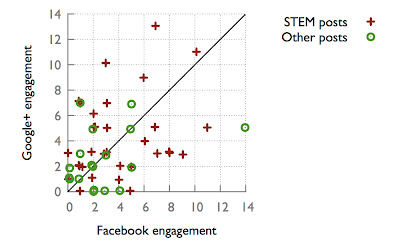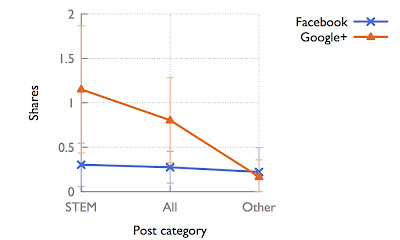Here's a little statistically-insignificant self-experimentation, based on 51 near-simultaneous posts to both Google+ and Facebook, from the beginning of September 2011 to the present.
"Engagement" is the number of unique people (excluding me) who responded, either by commenting, liking or +1'ing the post, or liking or +1'ing a comment on the post. (The scatterplot points are perturbed slightly from their true integral values so they don't completely overlap.) What's remarkable here is how coincidentally similar the engagement is on the two networks — the difference is under 2 percent (!) despite the fact that my social network on Facebook is currently 2.25 times as large as on Google+.
Google+ has very slightly higher engagement on STEM-related posts (science, technology, engineering, and mathematics), while Facebook is slightly higher for other posts, but the differences are well within 95% confidence intervals.
It's possible my social network has somewhat shifted to Google+. Here is the post set split into five chronological partitions with 10 or 11 posts in each.
Engagement as defined above excludes re-sharing posts, because I wasn't confident the two social networks are reporting these in the same way (e.g., do they both report recursive shares?). But there is some interestingly significant difference in sharing behavior on Google+ with STEM posts seeing nearly seven times as much sharing as non-STEM posts in this very small data set, an effect which didn't appear on Facebook.
Of course, all of this is specific to my social network, and really, the sample size is too small to draw any conclusions at all. Now, if someone were to compare posts for a large number of people that cross-post publicly to Facebook and Google+, that could start to get interesting...








As Google+ was opened to the public, Google employees were a large portion of the initial set of users. Google employees have a strong STEM bias. Assuming that people choose to use these sorts of services based on how many of their friends use it, maintaining the initial bias as new people join is not surprising.
ReplyDeleteRight. Actually, given that intuition, the Facebook and G+ lines in the second figure might be more similar than one would expect.
ReplyDeleteWhat's probably more surprising is the difference between the second and fourth figures.
How do you personally search for info for your new posts, which particular search resources or techniques do you generally utilize?
ReplyDeleteI think this is an informative post and it is very useful and knowledgeable. therefore, I would like to thank you for the efforts you have made in writing this article. scottsdale fine jewelers
ReplyDelete